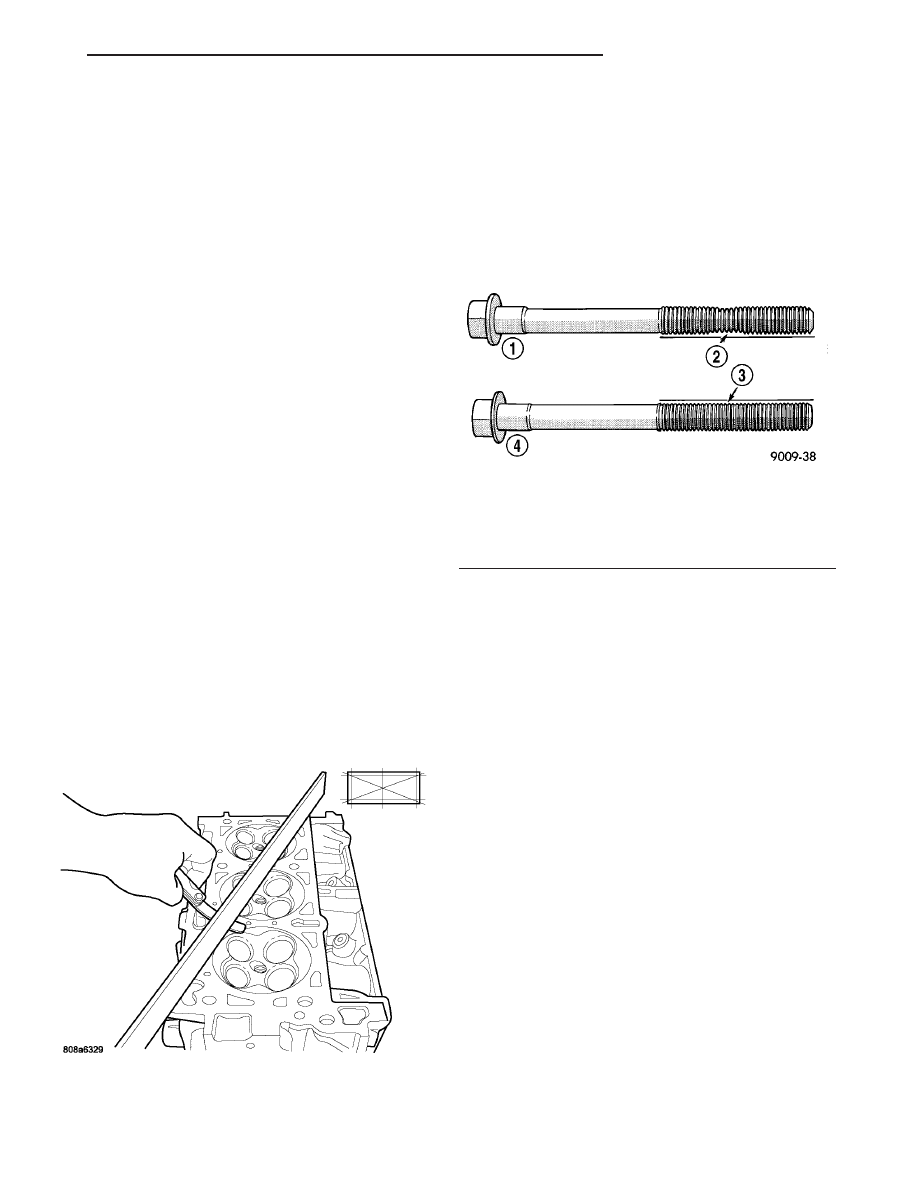Chrysler Sebring, Stratus sedan, Sebring Convertible. Manual - part 519

(25) Remove cylinder head(s).
(26) Remove and discard cylinder head gasket.
(27) Clean cylinder head and block sealing sur-
faces. (Refer to 9 - ENGINE/CYLINDER HEAD -
CLEANING)
CLEANING
To ensure engine gasket sealing, proper surface
preparation must be performed, especially with the
use of aluminum engine components and multi-layer
steel cylinder head gaskets.
NOTE: Multi-Layer Steel (MLS) head gaskets require
a scratch free sealing surface.
Remove all gasket material from cylinder head and
block (Refer to 9 - ENGINE - STANDARD PROCE-
DURE). Be careful not to gouge or scratch the alumi-
num head sealing surface.
Clean all engine oil passages.
INSPECTION
(1) Before cleaning, check for leaks, damage and
cracks.
(2) Clean cylinder head and oil passages.
(3) Check cylinder head for flatness (Fig. 21).
(4) Cylinder head must be flat within:
• Standard dimension = less than 0.05 mm (0.002
inch.)
• Service Limit = 0.2 mm (0.008 inch.)
• Grinding Limit = Maximum of 0.2 mm (0.008
inch.) is permitted.
CAUTION: 0.20 mm (0.008 in.) MAX is a combined
total dimension of the stock removal limit from cyl-
inder head and block top surface (Deck) together.
INSTALLATION
NOTE: The cylinder head bolts are tightened using
a torque plus angle procedure. The bolts must be
examined BEFORE reuse. If the threads are necked
down the bolts must be replaced (Fig. 22)
Necking can be checked by holding a straight edge
against the threads. If all the threads do not contact
the scale, the bolt must be replaced (Fig. 22)
CAUTION: When cleaning cylinder head and cylin-
der block surfaces, DO NOT use a metal scraper
because the surfaces could be cut or ground. Use
ONLY a wooden or plastic scraper.
(1) Clean sealing surfaces of cylinder head and
block (Refer to 9 - ENGINE - STANDARD PROCE-
DURE).
(2) Install new head gasket over locating dowels.
(3) Install cylinder head to block, assuring head is
properly positioned over locating dowels.
(4) Lubricate bolt threads with clean engine oil
and install bolts.
(5) Tighten bolts in sequence shown in (Fig. 23),
using the following steps and torque values:
• Step 1: Bolts 1–8 to 48 N·m (35 ft. lbs.)
• Step 2: Bolts 1–8 to 75 N·m (55 ft. lbs.)
• Step 3: Bolts 1–8 to 75 N·m (55 ft. lbs.)
• Step 4: Bolts 1–8 to +90° Turn Do not use a
torque wrench for this step.
• Step 5: Bolts 9–11 to 28 N·m (250 in. lbs.)
(6) For left cylinder head installation:
• Install engine oil dipstick tube.
• Install generator.
(7) For right cylinder head removal:
• Install cylinder head ground strap.
• Connect EGR valve electrical connector (if
equipped).
(8) Install all valvetrain components and cam-
shafts (Refer to 9 - ENGINE/CYLINDER HEAD/
Fig. 21 Checking Cylinder Head Flatness—Typical
Fig. 22 Check for Stretched Bolts
1 - STRETCHED BOLT
2 - THREADS ARE NOT STRAIGHT ON LINE
3 - THREADS ARE STRAIGHT ON LINE
4 - UNSTRETCHED BOLT
JR
ENGINE 2.7L DOHC
9 - 179
CYLINDER HEAD (Continued)